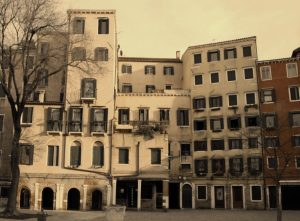Italy

Ghetto Vecchio, Venice. By Kodaly – Own work, CC BY-SA 3.0, https://commons.wikimedia.org/w/index.php?curid=18947015
Immediately after the Expulsion, the flourishing port cities of the kingdom of Naples, especially Naples itself, became destinations of choice for the exiles from Castile and Aragon, as well as for the exiles from the nearby Spanish-held islands of Sardinia and Sicily. The king of Naples had been favorable to Jewish settlement even before the expulsion. But the settlement in Naples was not long-lived. When the French army invaded in 1495, the Jews were among those who fell victim to the invading army, and those of them who could do so, fled. (The most well-known of these refugees was the biblical commentator Isaac Abarbanel.) Any Jews still left in Naples were expelled in October 1496.
Many Jews who originally arrived in Naples (or for that matter elsewhere in Italy) eventually gravitated to Ferrara, whose duke granted favorable terms of settlement, or to Rome, with its ancient Jewish community that still enjoyed the permissive rule of the Renaissance popes. But many exiles were unwilling to re-settle permanently in a Catholic country, and preferred to make Italy a way-station en route to the Ottoman Empire. Eventually, certain Italian cities – Venice, Ancona, Livorno – became places of settlement for “Levantine” merchants, that is, descendants of Spanish exiles who had settled in the Ottoman Empire and who continued to maintain their status as Turkish subjects, but who became an important semi-transient element in the Jewish communities of these cities. In Venice the number of the “Levantine” Jews settlers became so large that in 1541 the Venetian authorities allotted them a separate living quarter, the Ghetto Vecchio, “in order that they should have a greater incentive to come to this city with their merchandise, to the city’s benefit.”
Italy also became a place of settlement for conversos who fled the Spanish and Portuguese dominions after the Expulsion. Settling in the communities of the exiles, where they reverted to Judaism, it was fairly easy to conceal the fact that they had been baptized in the Peninsula. In any case, the papal inquisition in Italy did not have the aggressive character of the Spanish and Portuguese inquisitions. Conversos who came directly from the Peninsula, known as “Ponentine” Jews, settled in Venice, Ferrara, Ancona, and the Papal States, integrating themselves with relative ease into the Sephardic communities there. In Venice they generally went unmolested over the entire early modern period, during which they continued to settle there in small numbers. This was not the case in the Papal States. While at first the popes turned a blind eye to their status as baptized Catholics (which technically rendered their reversion to Judaism heresy), in 1556, under the momentum of the Counter-Reformation pope Paul IV, this policy was abandoned. In May of that year, a new policy was ushered in with events that reverberated throughout the Sephardic world- in Ancona, twenty-four conversos were arrested, tried, and burned at the stake. Conditions for Jews in Italy were generally deteriorating by this time, so that Italy was in any case a less attractive destination for conversos fleeing Spain and Portugal. Italy’s Sephardic communities continued to maintain themselves, but it was only Livorno, where Jews were allowed (indeed invited) to settle on excellent terms from 1593 onwards, that attracted large numbers of émigrés from the Peninsula.
Secondary Sources
- Foa, Anna. “Converts And “Conversos” In Sixteenth-Century Italy- Marranos in Rome.” In The Jews of Italy- Memory and Identity, edited by Bernard Dov and Barbara Gavin Cooperman. Bethesda- University Press of Maryland, 2000.
- Saperstein, Marc. “Martyrs, Merchants and Rabbis- Jewish Communal Conflict as Reflected in the Responsa on the Boycott of Ancona.” Jewish Social Studies 43, no. 3 (1981)- 215-228.
- Segre, Renata. “Sephardic Settlements in Sixteenth-Century Italy- A Historical and Geographical Survey.” Mediterranean Historical Review 6, no. 2 (1991)- 112-137.
- Zeldes, Nadia. “Diffusion of Sicilian Exiles and Their Culture as Reflected in Hebrew Colophons.” Hispania Judaica Bulletin 5 (2007)- 303-332. [NOTE- There are numerous primary sources–translations of colophones]
- Zeldes, Nadia. “The Account Books of the Spanish Inquisition in Sicily (1500-1550) as a Source for the Study of Material Culture in a Mediterranean Country.” Mediterranean Historical Review 14, no. 2 (1999)- 84-89 (primary source).
- David, Abraham. “The Spanish Expulsion and the Portuguese Persecution through the Eyes of the Historian R. Gedalya Ibn Yahya.” Sefarad 56, no. 1 (1996)- 45-59. Abstract- About Italian rabbi Gedalia Ibn Yahia (1526-87), the son of Portuguese Jews who fled to Italy in the late 15th century to escape persecution, copyist and author. Examples from his Shalshelet Ha-Kabbalah [Chain of tradition] concerning the persecution of Iberian Jews show that Gedalia attempted to supplement and enrich the bare facts with new information based on additional Jewish and non-Jewish sources. Gedalia’s aim was to provide information based on his understanding of the situation and personal observation. These aspects determine his place in 16th-century Jewish historiography.
What do you want to know?
Ask our AI widget and get answers from this website